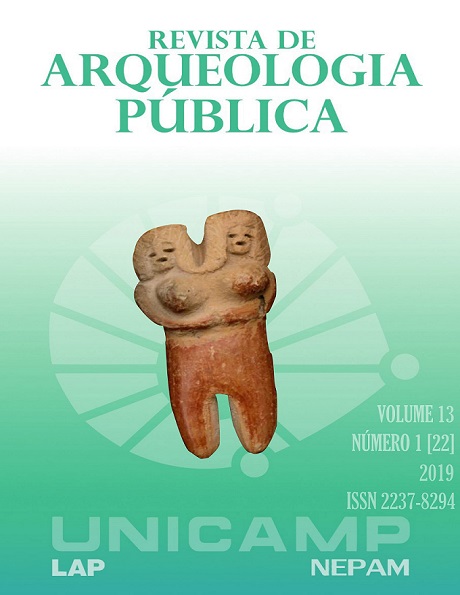Abstract
The present article analyzes the Discovery Tourmode, developed by Ubisoft Montreal for the game Assassin’s Creed Origins.The Discovery Tourmode is proposed by its developers as a “purely educational” tool, understood as a “Virtual Museum” aiming at aiding students to understand the past through guided tour concerning Egyptian life and its historical sites. It will be questioned in this study the censorship enacted against the nudity of Classical statues, considering that they are censored solely in this gaming mode, in which the genitals and nipples statues of Greek Gods and Goddesses appear covered by seashells, raising several issues concerning today’s education and the oversexualized gaze over the past.
References
ALVES, Luciana; BIANCHIN, Maysa. O Jogo como Recurso de Aprendizagem. Revista Psicopedagogia, São Paulo, v. 27, n. 83, p. 282-287, 2010.
BARBIERI, Loris; BRUNO, Fabio; MUZZUPAPPA, Maurizio. Virtual museum system evaluation through user studies. Journal of Cultural Heritage, v. 26, p. 101–108. 2017.
BEIER-DE HAAN, Rosmarie. Re-Staging Histories and Identities. In: Macdonald, Sharon. (Ed.) A Companion to Museum Studies. Oxford: Blackwell Publishing, p. 186-198, 2006.
BERRY, David. Understanding Digital Humanities. New York: Palgrave Macmillan, 2012.
BOARDMAN, John. Greek Sculpture: The Archaic Period. London: Thames and Hudson, 1996.
BOARDMAN, John. Greek Sculpture: The Classical Period. London: Thames and Hudson, 1995.
BOARDMAN, John. Greek Sculpture. The Late Classical Period. London: Thames and Hudson, 1995.
BRUNO, Cristina. Museus, identidades e patrimônio cultural. Revista do Museu de Arqueologia e Etnologia. Suplemento 7. São Paulo, 2008, p. 145-151.
BUTLER, Judith. Gender Trouble. New York; London: Routledge. 1990.
CLARK, Jeffrey. The Fallacy of Reconstruction In: FORTE, Maurizio. (Ed.). CyberArchaeology. Oxford: Archaeopress, BAR v. 2177, p. 63-74, 2010.
COVER, Rob. The Naked Subject, Context and Sexualization in Contemporary Culture. In: Body & Society, v. 9. n. 3, London; Thousand Oaks; New Dehli: Sage Publications, 2003, p. 53-71.
FOUCAULT, Michel. História da Sexualidade: O Cuidado de Si. v 3. Rio de Janeiro: Edições Graal, 1985.
INSOLL, Timothy. Introduction: configuring identities in archaeology. In: INSOLL, Timothy (ed.). The Archaeology of Identities: A Reader. London; New York: Routledge, 2007, p. 1-18.
MCCALL, Jeremiah. Teaching History with Digital Historical Games: An Introduction to the Field and Best Practices. In: Sage, v. 47, n. 4, p. 1-26, 2016.
MCMICHAEL, Andrew. PC Games and the Teaching of History. In: The History Teacher, v. 40, n. 2, p. 203-218, 2007.
MOSCHINI, Rosanita; CAIERÃO, Iara. O Brincar na Clínica Psicopedagógica. Revista Psicopedagogia, São Paulo, v. 32, n. 99, p. 361-365, 2015.
MPAA. Classification and Rating Rules. Sherman Oaks & Washington: 2010.
PIVEC, Maja; KRONBERGER, Anika. Virtual Museum: Playful Visitor Experience in the Real and Virtual World. 8th International Conference on Games and Virtual Worlds for Serious Applications (VS-GAMES), 2016. p. 1-4.
SANTOS, Dominique. De tablet para tablet ‐ novas ferramentas para a pesquisa e o ensino
da história das culturas cuneiformes na era digital. Revista Tempo e Argumento, Florianópolis, v. 6, n. 12, p. 212 ‐ 241, mai./ago. 2014.
SCHREIBMAN, Susan; SIEMENS, Raymond; UNSWORTH, John (eds.). A companion to Digital Humanities. Malden; Oxford; Victoria: Blackwell Publishing, 2004.
SCHWEIBENZ, Werner. The Development of Virtual Museums. ICOM News, v. 57, n. 3, p. 3. 2004.
SHANKS, Michael; TILLEY, Christopher. Reconstructing Archaeology: theory and practice. Cambridge, Cambridge University Press, 1992.
SMITH, Roland. Hellenistic Sculpture. London: Thames & Hudson World of Art, 2005.
TAHINCI, Anna. Removing the feags leaf: todays Nudity in the American Public Eye. Sculpture Review. v. 57, n. 2 p. 16-23, 2008.
VOUT, Caroline. Sex on Show: Seeing the Erotic in Greece and Rome. London: British Museum Press, 2013.
The Guardian. Disponível em: https://www.theguardian.com/technology/2017/oct/05/assassins-creed-originsrecreated-ancient-egypt-ubisoft. Acesso em: 25. 04. 2019.
ICOM - International Council of Museums. Disponível em: https://icom.museum/en/. Acesso em: 16. 02. 2019.
Ubisoft. Disponível em: https://support.ubi.com/en-gb/Faqs/000031846/Discovery-Tour-Mode-of-Assassins-Creed-Origins-ACO. Acesso em: 25. 04. 2019.
PC Games News (PCGamesN). Disponível em: https://www.pcgamesn.com/assassins-creed-origins/assassins-creed-originsdiscovery-tour-nude-statues-censorship. Acesso em: 20. 02. 2019.
Schnapp, J. and Presner, P. Digital Humanities Manifesto 2.0., 2009.
Smithsonian. Disponível em: https://www.smithsonianmag.com/arts-culture/true-colors17888/?c=y&page=3, Acesso em: 26. 02. 2019.
A Revista Arqueologia Pública utiliza a licença do Creative Commons (CC), preservando assim, a integridade dos artigos em ambiente de acesso aberto.


